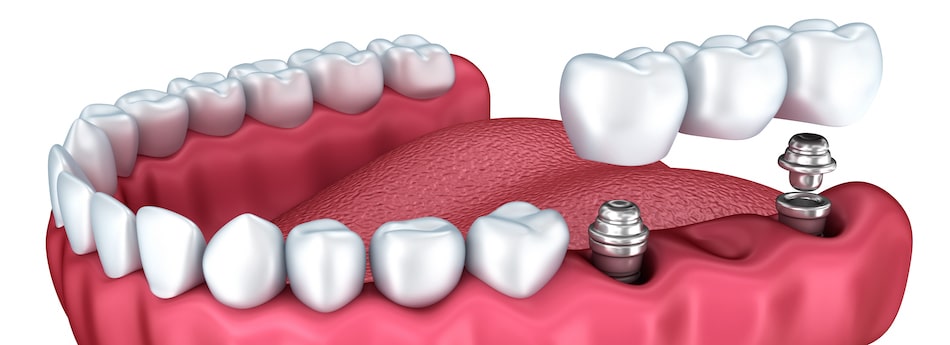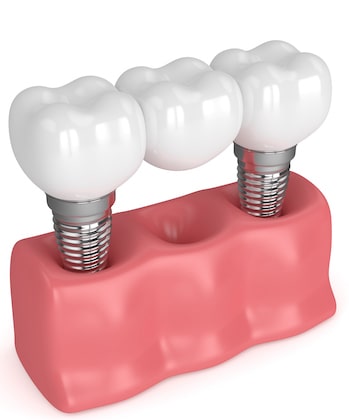
When a tooth is missing and a patient wants to replace it, dentists can place a dental bridge in the mouth to replace the missing tooth (as well as multiple teeth). A dental bridge is made of several pieces that are combined together to fit the open space where the tooth is missing. Let’s examine how a dental bridge is made and the benefits it provides to the mouth.
In general, a dental bridge is able to help a person enjoy an improved ability to eat and speak while also improving the look of the mouth. While a dental bridge can be made of alloys, gold, or porcelain, a dental bridge used to replace a front tooth is often made of porcelain so it can more easily match the natural color of the tooth.
The artificial tooth that is used as part of a dental bridge is called a pontic and patients will need to have a pontic for each tooth that is missing in the mouth. The dentist creates the pontic to be similar in size and shape to the missing tooth and it is anchored to a tooth that is next to the gap in the mouth (known as abutment teeth) or it is anchored to a dental implant.
There are three commonly used dental bridges and they include:
Some of the advantages of having a dental bridge placed in the moth include the ability to speak normally (since missing teeth can make it hard to enunciate), restoring a natural look to the mouth, making it easier to chew food, preventing bone loss by maintaining the normal structure of the face, and preventing any other teeth from moving into the empty space if they are adjacent to the gap in the mouth.
 Patients who want to have dental bridges placed in the mouth normally have two procedures performed to complete the process. In addition, the dentist will take an impression of the teeth that are sent to a lab to create the dental bridge.
Patients who want to have dental bridges placed in the mouth normally have two procedures performed to complete the process. In addition, the dentist will take an impression of the teeth that are sent to a lab to create the dental bridge.
A traditional bridge starts with the preparation of the abutment teeth. The dentist will need to remove some of the dentin and enamel from the abutment teeth so there will be room for the crown. A temporary dental bridge is then placed over the treated teeth in order to protect them until the dental bridge is put in place. During a second appointment, the dentist will remove the temporary crown, place the permanent crown and dental bridge, and then cement the dental bridge into place.
An implant-supported bridge places the implants in the jawbone so surgery is required to perform this step. Besides needing time to heal from the surgery, a patient might need to wear a temporary bridge until the next appointment when the permanent bridge is placed over the implants.
A Maryland bridge involves less appointments as the abutment teeth only need a little bit of etching on their back to make it easier for the “wings” to bond to the teeth. The dentist will then place the bridge, bond the “wings” to the abutment teeth using resin, and then curse the resin.
Unlike dentures, dental bridges are considered to be permanent as they cannot be removed from the mouth. They can last anywhere from ten to fifteen years if they are properly cared for by the patient. Dental bridges will last if the person practices proper oral hygiene to keep the rest of the teeth healthy and strong. The patient should not eat food such as hard candy or chewy snacks while also avoiding popcorn and nuts that can damage a dental bridge.
Overall, a dental bridge can be an effective and long-lasting solution to address the issue of missing teeth in the mouth. Patients who are interested in learning more about dental bridges should schedule a consultation appointment with a dentist who is both experienced and board-certified in examining the mouth of a patient and determining if the person is an ideal candidate for dental bridges in the mouth.
- MA